Archive for April, 2020

Universe Sandbox Roadmap: 2020 & Beyond
Apr 30th

Universe Sandbox has improved significantly since our first Early Access release in 2015. We plan to add features and fix bugs for a long, long time to come (we even removed the “2” from our name for that reason). Here’s a look into what we have planned for 2020 and beyond.
What did we do in 2019?
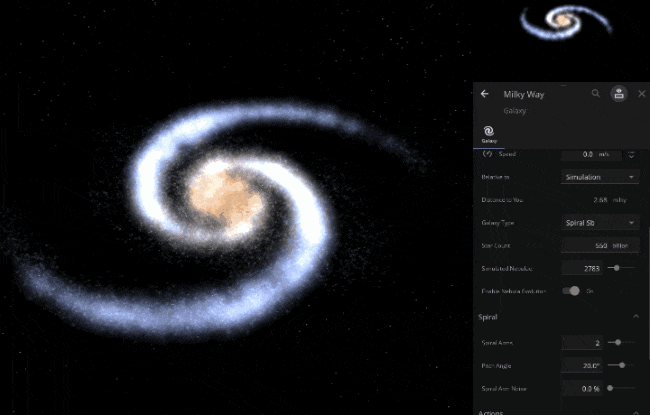
Last year saw 3 major feature releases (and a handful of minor, but still important, updates):
- Better Galaxies (Update 23)
- More stable and accurate galaxies and better collisions
- New and improved Introduction tutorial for helping new users
- Surface Grids & Lasers (Update 24)
- Surface Grids is a huge, complex feature that simulates the surfaces of planets, moons, and other objects
- Vaporize entire planets with the new Laser tool
- Custom Object Colors (Update 24.1)
- Customize colors for just about every object including planets, moons, stars, and black holes
- Dock graph windows alongside the other panels added with Surface Grids
View our “What’s New” for a chronological list of changes.
What’s the Plan for 2020?
The following list are all things we are working on currently. We’re aiming to deliver on all of this in 2020, but when they’ll be ready is difficult to predict, and priorities can change.
With its ability to simulate localized surface temperatures, water level, vapor content, and more, Surface Grids (Update 24) perfectly sets us up for a multitude of new features. Localized temperatures enabled us to create the mighty Galactic Empire Superlaser, but that’s only scratching the surface…
Surface Grids Improvements
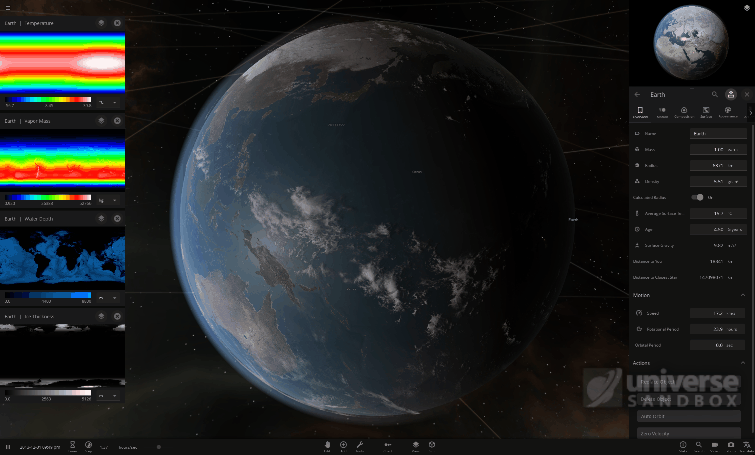
We’ve been saying that Surface Grids is the foundation for many things to come, so it only makes sense that we start the year off by further improving it.
- Improved Temperature & Atmosphere Simulation
- Surface Grids improvements started this year in January (Update 24.1.2), continued with Update 25 (March 2020), and will be a theme all year long
- Update 25 introduced a major rewrite to Tidal Heating and Vapor Flow calculations
- Better Performance & More Power
- Not only have we accomplished localized surface simulations on your everyday computer, but we continue to make performance improvements
- Shader Model 5.0, a graphics card technology, became a requirement in Update 25 because it will give us some legroom for current and future enhancements
- Detailed Surface Manipulation
- We are in the early stages of designing tools that allow for directly manipulating temperature, elevation, water level, vapor, and more on the surfaces of objects
- We plan to add the ability to view and edit the properties of individual surface grid “cells”. Take your planet customization and terraforming to a new heights with a level of precision you never thought possible
Material Composition System
Building off of the localized materials (water, CO2) in Surface Grids, we’re working to rebuild our material composition in a more robust way.
- Better System to Unify Materials
- Every point on the “grid” will better contain a mixture of various materials, in various material states
- Complicated calculations of, for example, when some liquids become heated to a gas, should be handled more efficiently in our new simulation code
- A Universe of Possibility
- Better terraforming, more realistic cloud and climate simulations, tidal waves, easy ways to manipulate the surface topography, and more detail on the surface view could all be the results of this new Material Composition System
- Who knows, maybe our planets could one-day support life?
Full Desktop User Experience in VR
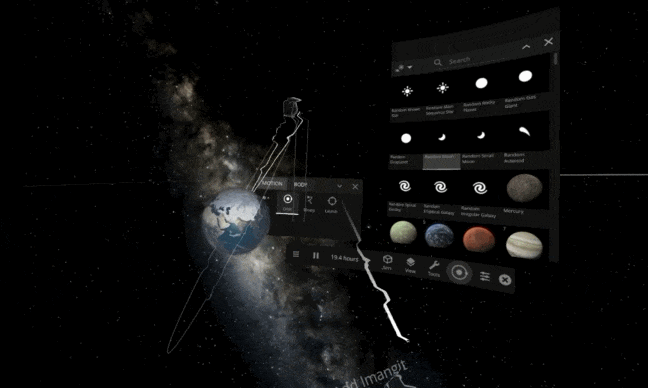
We have embraced a seemingly impossible goal of having a unified Universe Sandbox release no matter how you play. Whether you are on a powerful gaming PC, a laptop, a phone (coming soon), Virtual Reality, Mixed Reality, or a console (maybe soon? who knows!) the experience should be undiluted and awe-inspiring.
- A Magic Leap Forward
- With our recent Magic Leap 1 release, we were able to bring the full Desktop experience to the world of Mixed Reality
- Hard work pays off: the bulk of our Magic Leap 1 development helped unify our Mixed Reality, VR, and Desktop experience into one single vision
- Get Your Hands on it
- Enjoy Universe Sandbox in VR without limitations and with the full Desktop User Interface
- Grab planets with your hands, shoot lasers out of your fingertips, and watch galaxies collide as if you were really there, floating in space (but a bit less cold).
User Interface Improvements
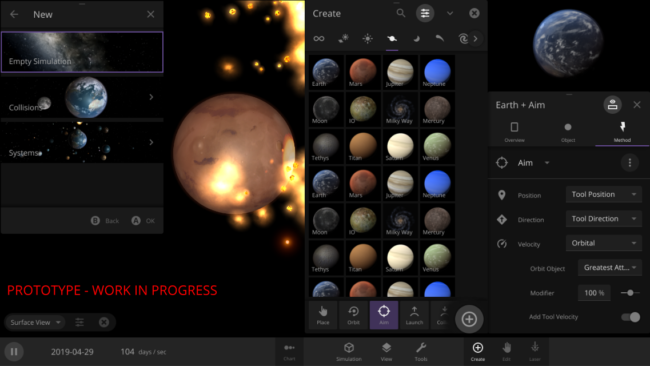
Creating the user interface (UI) for Universe Sandbox is a fun challenge. How do you give someone full control of the universe? As we add features and complexity to the simulation, keeping the UI accessible, discoverable, and easy to use becomes a constant challenge.
Over time, some portions of the interface can start to feel cluttered or outdated and are ready for a redesign. We’ve been working on some of these design changes for a long time, and it’s exciting to move closer to improving everyone’s experience with Universe Sandbox.
- Redesigned Bottom Bar
- Our current bottom bar has been collecting new buttons over the years without a cohesive vision for how it should all work. So we’ve rethought how everything should be organized and how we can make it work on really small screens.
- Improved Add Panel
- Like the Bottom Bar, the Add Panel is due for a makeover. We’re targeting a single shared UI for all platforms (desktop, touch, VR/AR, and consoles), so the new Add Panel is being built with that in mind.
…and beyond?
Mobile
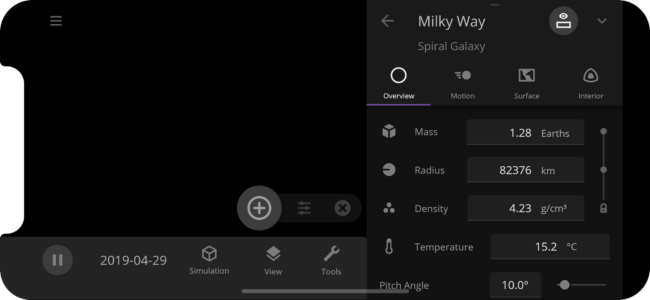
Enjoy Universe Sandbox on your phone or tablet! Sign up to get notified about our mobile version.
- Is that Universe Sandbox in Your Pocket?
- Our mobile version is in development right now for both Android and iOS. It’s no easy feat to simulate the universe on a smartphone, but we’re doing it!
- A Pure, Unadulterated Experience
- Some of the breakthroughs we made with both Surface Grids and Magic Leap have paid off and will allow for the full desktop version on your pocket-sized device
Life Simulation
Create the right conditions for life and watch it grow, or end it all with a major impact.
- Turn a cold, lifeless space rock into a vibrant planet
- Many details are still TBD, keep an eye out for a DevLog when we get started
Fluid Simulation

Smoothed-particle Hydrodynamics (SPH) will help create more detailed, realistic simulations of collisions, fragmentation, and formation of different types of objects. Read more in our SPH Fluid Simulation DevLog.
Experiments with Tools

This is firmly in the realm of experimentation at the moment, but we’re looking at new and interesting ways we can use our tools within a simulation. Driven by a need to automate testing of features, we’re working on ways to programmatically activate tools. By automating and attaching different tools to objects, we discovered that we can enable some pretty fun scenarios. The above clip is what happens when we attached a bunch of lasers to moons and tell it to automatically fire at the nearest object. Awesome stuff, right?
Gamepad Support… and more?
Do you want to sit back on your couch and play Universe Sandbox? So do we! We’ll be experimenting with full gamepad support. Who knows where that leads us, maybe even a console version in the future.
Hiring
We are currently hiring a Spaceship Physics Developer, join us!

Light It Up | Update 25.1
Apr 20th
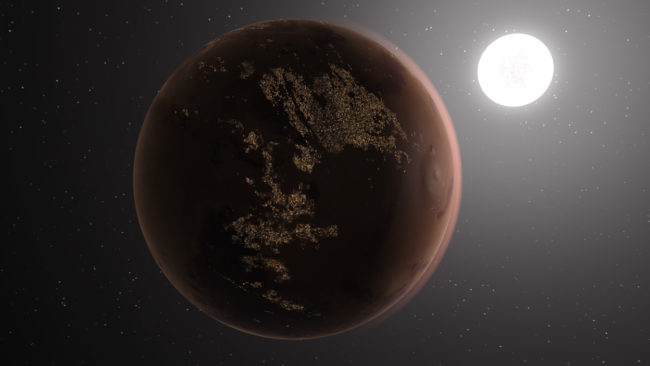
Run Steam to download Update 25, or buy Universe Sandbox via our website or the Steam Store.
Update 25.1 includes a host of bug fixes and lighting improvements, as well as a fun oft-requested feature to add customizable city lights to any rocky planet or large moon.
City Lights on Any Planet
You can now enable City Lights on any rocky planet or large moon by going to Object Properties > Appearance > City Lights. Select from Earth’s city map or a randomized procedural map, and define whether the lights will turn off if the surface is deemed uninhabitable.
Lighting Improvements
The interaction of multiple light sources has been reworked, particularly with how they reflect off an atmosphere.
General Fixes
We fixed a bunch of miscellaneous issues, including improving how supernova clouds impact objects, star temperature instability, orbit previews, shadows, and more.
Please report any issues on our forum, on Discord, or in-game via Home > Send Feedback.
